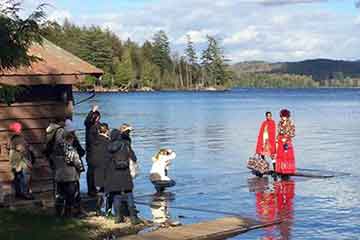Bulletin News

12/05/2017
SUNY Cortland students studying at the College’s outdoor education center at Raquette Lake expect to see deer, loons, maybe even a fox.
But this May, some 50 physical education majors arrived at the remote, Adirondack wilderness site to find a pair of sophisticated models surrounded by a professional Vera Bradley photography crew.
The crew of approximately 31, led by international freelance fashion photographer Anne Menke, had selected SUNY Cortland’s William H. Parks Family Center for Environmental and Outdoor Education as the perfect location to shoot images promoting Vera Bradley’s 2017 fall collection of handbags and accessories.
Some of those images recently began appearing in holiday advertisements for Vera Bradley. This includes a YouTube video, and a sampling on Vera Bradley’s official Instagram site.
“They were looking for the rustic atmosphere, I would say, the outdoor feel,” said Rhonda Pitoniak ’01, M ’16, the College’s director of outdoor education. “Because this was their winter shoot, they wanted to capture the feel of very late fall, cold weather, which was why they wanted to shoot in May before leaves came out on trees and things became too lush.”
On May 15, 48 students accompanied by 11 Physical Education Department faculty and staff members stepped onto the dock at the Huntington Memorial Camp ready to begin a rustic, outdoor education experience, just as the Vera Bradley crew was wrapping up.
The photographers, who had begun at 6:30 a.m. that day, were snapping various scenes including shots of two models stepping on and off a seaplane at the camp’s main dock while loaded down with Vera Bradley handbags and luggage in a dazzling array of warm fall colors and patterns.

The unusual encounter occurred in the early afternoon as the future physical educators arrived to fulfill their outdoor physical education requirement. That gave the students a couple of hours to watch the camera crew before they left on the boat shuttle by about 4 p.m.
“It was really fun to watch that day, it was a great learning experience,” Pitoniak said. “I just couldn’t see how 29 people could be busy all day with two models …. The rest of the folks were responsible for doing a variety of different things. Some would run and get hot drinks if they wanted them, or bug spray. Some were in charge of props. Some were there for hair and makeup, some for staging. Everyone had their job. They would be standing around and suddenly run away and do their job and then come back. It was an amazing process to see unfold.”
At one point, members of the photography group looked on while the students were instructed to leap from the dock for an approximately 50-foot swim test in the cold, dark waters of Raquette Lake.
“A number of the people who were working the shoot told me it was cruel to make the students get in the water because it was so cold,” Pitoniak said. “But I shared with them that it was tradition and there were teaching and learning reasons behind it. It’s a really short swim.”
In 2004, the U.S. National Park Service officially designated the former Camp Pine Knot site, which the College has owned since 1948, as a National Historic Landmark. Located on Raquette Lake’s Long Point, Camp Huntington is the original Adirondack great camp designed by William West Durant during the Gilded Age. The camp is accessible only by boat in the summer and by ice road during the winter. Both students and Vera Bradley crew took boat shuttles to and from the dock of a second camp owned by SUNY Cortland that has road access, the W.H. Parks Family Outdoor Education Center, Antlers.
The photo crew originally had planned to take pictures only at nearby Great Camp Sagamore, another Adirondack Great Camp also designed by Durant.
But Menke, who had shot for Spanish Vogue at Camp Huntington in 2006, expanded the scope of the May 2017 Vera Bradley photography session.
“One of the things that brought them back to Camp Huntington was that they had really loved the Caretaker’s Cabin dock,” Pitoniak said. “When Anne was here previously it was flooded and was underwater, which was really unusual in July. They could make it look like the model was floating on top of the water. They had hoped for that again and, fortunately, it was flooded enough this time to be able to photograph that way again.
“As far as I know, that was the first time we had fashion photography here,” Pitoniak said.
The SUNY Cortland location had other advantages for what Menke had in mind.
“They had brought in a seaplane to take pictures at the main dock on Raquette Lake because Sagamore on Sagamore Lake is motorless so they couldn’t have the planes come in there,” Pitoniak said.
“They shot with the models in a few different places, mainly the Swiss Chalet, the porch of the Trapper’s Cabin, an outdoor area and at the lean-to,” Pitoniak said. “They also had the still photographers working on the end of Durant Cabin, hanging some of the bags off of the deer antlers and photographing them there as well as the Adirondack chairs around camp in various places.”
Among the more iconic images captured at Camp Huntington was one of a model in a top hat posed in front of the Swiss Chalet cabin door.
Pitoniak and Richard Fey, the camp caretaker, were allowed to take and share a few images of their own.
Pitoniak had been contacted on behalf of Vera Bradley by Angelika Saint-Aignan from Boutique Productions on May 3, about a week and a half before the day of the actual 10-hour-long shoot.
The only day possible for her to schedule was for May 15, a Monday, and it would be a very tight fit.
“We had the large group coming that takes up all of Camp Huntington, but they wouldn’t be there yet,” Pitoniak said. “I contacted (P.E. instructor) Kate Hovey to see if it would be too intrusive. She didn’t think it would really interfere a whole lot as long as they were out of particular buildings, mainly Metcalf Hall by then so we could start our lectures. Then I went back to Vera Bradley’s logistics manager and said ‘We have these considerations.’”
The terms were reached. Pitoniak was not sure what to expect on the day of the shoot.
“They were so kind and courteous, and really conscientious of where they were,” she said. “They asked permission to do things like put a tack in a wall or move a particular piece of furniture. I thought about it later and decided that they are used to working in other people’s spaces.”
So now along with the loons and foxes and deer and pristine quiet are some pretty interesting memories.

